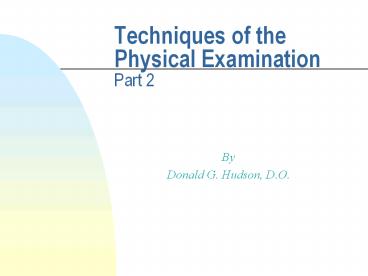Techniques of the Physical Examination Part 2 - PowerPoint PPT Presentation
1 / 37
Title:
Techniques of the Physical Examination Part 2
Description:
Techniques of the Physical Examination Part 2 By Donald G. Hudson, D.O. Objectives Discuss methods of examining each body system Compare normal vs. abnormal findings ... – PowerPoint PPT presentation
Number of Views:316
Avg rating:3.0/5.0
Title: Techniques of the Physical Examination Part 2
1
Techniques of the Physical ExaminationPart 2
- By
- Donald G. Hudson, D.O.
2
Objectives
- Discuss methods of examining each body system
- Compare normal vs. abnormal findings
- Review potential abnormal findings and their
potential relevance
3
Reminders
- Keys to the Physical Exam
- Inspection
- Palpation
- Auscultation
- Percussion
- Key Tools in the Physical Exam
- BP cuff Stethoscope
- Senses
4
Skin Nails
- General Appearance Potential Abnormalities
- Jaundice, Cyanotic, Pale, Pink/Norm
- Moist, dry, exfoliation
- Hot, warm, cool, cold
- Lesions
- Petechiae, Purpura (blanching?)
- cellulitis, pressure ulcer, burn, scar
5
The Skin
6
Skin Lesions
7
Primary Lesions
8
Primary Lesions
9
Skin Lesions
Kaposis sarcoma Bates, Barbara, MD. A Guide to
Physical Examination and History Taking, fourth
edition. J.B. Lippincott. 1987.
Malignant Melanoma Bates, Barbara, MD. A Guide
to Physical Examination and History Taking,
fourth edition. J.B. Lippincott. 1987.
10
Skin Lesions
Varicella
Cellulitis
11
Skin Lesions
Lyme Disease Rash
Urticaria
12
Skin Lesions
Port-Wine Stain
Rash from Rubber Product
13
Nails
Nail Psoriasis
Bates, Barbara, MD. A Guide to Physical
Examination and History Taking, fourth edition.
J.B. Lippincott. 1987.
14
Skin Lesions
What type of work might this person do?
What might have caused this?
15
HEENT
- Head Face
- old scar, size/shape, appearance
- Eyes
- Pupils
- Sunken, protruding
- periorbital ecchymosis or edema
- visual acuity
- Nose throat
- sounds, growths, tonsils
- Color (white, red, pink)
16
HEENT
17
HEENT
Cushings Disease
Myxedema
18
HEENT
Goiter
Exophthalmos
19
HEENT
Tonsils
Ulcerative basal cell carcinoma
20
HEENT
Acromegaly
21
HEENT
HYPHEMA
22
HEENT
SLE - Butterfly Rash
23
HEENT
- What specific testing or examinations should be
done with regard to the HEENT exam? - What specific abnormalities might you find and
why?
24
Neck
25
Neck
26
Chest Respiratory System
27
Chest Respiratory System
- What specific things should you consider
evaluating or examining with regard to the chest
respiratory system? (Groups 1 2) - What are some abnormal findings and what might
they tell you about the patient? (Group 3) - Group Discussions
28
Cardiovascular
What is a likely chronic illness for this person?
What is this condition?
29
Cardiovascular
Thrombophlebitis
30
Cardiovascular
- What specific questions, tests, examinations, etc
should you include when assessing the entire
cardiovascular system (include peripheral
vascular)? (Groups 2 3) - What might these findings tell you about your
patient? - What are the specific organs and structures
involved in the assessment? (Group 1) - Group Discussions
31
Abdominal
32
Abdominal
33
Nervous System
34
Neurologic System Exam
- LOC, Pulse, Motor and Sensory are the basics
- Cranial Nerves
- Pupillary response to light (III)
- Ocular movement (III, IV, VI)
- Clench teeth (V)
- Show teeth Raise eyebrows (VII)
- Open mouth and stick out tongue (XII)
- Gag Reflex (IX, X)
- Shrug shoulders (XI)
- Symmetry, Pain response, Point discrimination
35
Nervous System
- What specific questions, tests, examinations, etc
should you include when assessing the entire
nervous system (exclude equipment testing such as
CT, MRI)? (Groups 1 3) - What might these findings tell you about your
patient? - What organs or structures are you assessing?
(Group 2) - Group Discussions
36
Additional Diagnostics
- Blood glucose level
- Pulse oximetry
- ECG
- Diagnostic (12 Lead) ECG
- Cincinnati Prehospital Stroke Scale
- Future
- Cardiac Enzymes, Predictive instruments,
Abdominal Ultrasound
37
Summary
- Examine each body system area when performing the
comprehensive physical exam - Consider knowledge of pathophysiologies and apply
to the physical exam
38
Laboratory Session
- Lung Sounds
- Heart Sounds
- Practicing the Comprehensive Physical Exam
including - history taking
- approaching the patient

